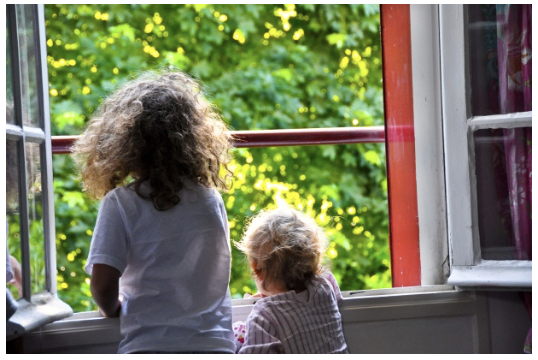Views and Operable Windows
New ResidentialWhat are Views and Operable Windows?
Indoor environments impact occupant well-being and productivity. Aspects of the indoor environment such as access to views and natural light, connection to nature, and personal control over environmental conditions all play a role in occupant comfort (see Individual Comfort Controls).[1] Access to views of the outside contributes to occupant well-being.[2] Many studies have found that people value daylight and prefer to be near windows, and there is a growing understanding that being near a window can be psychologically and physiologically beneficial, mainly if views contain natural features. Visual contact with nature through window views enhances mood, reduces stress, and promotes a higher quality of life (see Biophilic Design).[3] A study by Roger Ulrich compared postoperative recovery rates of patients experiencing similar surgical procedures but having different window views of trees and a lake, no window views, or a view of a brick wall. The study found that the window view patients recovered significantly faster, required less pharmaceutical assistance, and had fewer post-operative complications, supporting the idea that enhanced opportunities for emotionally bonding with nature promote feelings of calm, confidence, and personal well-being.[4]
Operable windows can increase occupant comfort and provide psychological benefits through natural ventilation, connection to natural elements and individual control over the indoor environment (see Natural Ventilation). Operable windows can also contribute to improved indoor air quality, depending on the quality of the outdoor air. Monitor outdoor air quality through resources such as the US EPA “Air Now” online tool (airnow.gov) that lists air quality conditions by zip code.[5]

Figure 1 – Window with a view of natural features (Source: Flickr Saad Kadhi).
How to Incorporate Views and Operable Windows
The factors that define indoor environmental quality connect directly to each other. For example, the decision about the placement or type of window can impact access to natural light, connection to the outdoors, acoustics, thermal comfort, occupant control, and air quality (see Energy-Efficient Windows).[6] It is essential to consider all of these components in the design phase of a project. There are many resources available regarding design steps to consider for the placement of operable windows and to optimize views (see Resources section).
Typically homes have operable windows that provide homeowners with the option of opening and closing the windows. With double glazed windows and screening, large windows can be used for aesthetics, daylighting and proper ventilation without unnecessary loss of heating and cooling. It is possible to have operable windows without wasting energy by integrating the HVAC system with a window switch. Whenever the system senses that the window is open, the heating and cooling air supply to that zone are turned off, allowing the open window to provide ventilation air while allowing the temperature to float. Using computer simulations, engineers have shown that natural ventilation coupled with a disabling of the HVAC system results in reduced energy use.[7]
Although there are many benefits associated with operable windows, there are also tradeoffs to consider. For example, operable windows can increase the threat of water and air leakage without careful window selection, design, and installation (see Reduce Air Infiltration). Operable windows can also increase noise and airborne pollutants in the interior space and make it harder to control thermal comfort with various types of HVAC systems (see Acoustic Control).
Benefits
Incorporating views and operable windows:
- Enhances occupant comfort and health
- Increases access to daylight and window views, which is likely to have positive impacts on psychological functioning and well-being
- Reduces stress and promotes positive emotional states and may also influence cognitive functioning[8]
- Reduces the need for mechanical ventilation
- Reduces energy use through increased daylighting
Costs
The cost of incorporating operable windows and maximizing views from interior spaces varies by project, and these aspects should be considered early in the design phase to optimize cost efficiencies. Operable windows are usually more expensive than static window units. Expect to pay approximately 20-percent more for fully operable windows vs. fixed windows. Price also changes by type of operable window – sliders are cheaper than casements, for example. Many factors affect cost and designers need to think holistically about the project. Operable windows can be used to offset mechanical ventilation costs and can allow for downsizing of mechanical systems. Installing a traditional mechanical HVAC unit in the home and installing operable windows can lead to inefficiencies in running the system if residents are not adequately aware of how to operate the home’s systems.[9]
Resiliency
In the event of a fire or other emergency in the home, operable windows (depending on their size) can act as a point of egress for occupants and can also serve as an access point for firefighters and their lifesaving equipment, especially if any other exits are blocked off and inaccessible to the home’s occupants. Operable windows can also help provide natural ventilation and thermal comfort during a power outage.[10]
[1] Whole Building Design Guide. Promote Health and Well Being http://www.wbdg.org/design-objectives/productive/promote-health-well-being (accessed January 12, 2019).
[2] GSA. Sustainable Facilities Tool. Occupant Comfort. http://www.wbdg.org/design-objectives/productive/promote-health-well-being(accessed January 12, 2019).
[3] Judith H. Heerwagen, Ph.D. Green Buildings, Organizational Success, and Occupant Productivity. Whole Building Design Guide. https://www.wbdg.org/files/pdfs/grn_bldgs_org_success.pdf (accessed September 20, 2018).
[4] Ulrich, Roger S. View Through a Window May Influence Recovery from Surgery. The Center for Health Design. https://www.healthdesign.org/sites/default/files/article-pdfs/Ulrich-1984-CHD-KPS.pdf (accessed September 20, 2018).
[5] US EPA. AirNow. https://www.airnow.gov (accessed December 12, 2018).
[6] California Sustainable Design Training. IEQ. https://www.calrecycle.ca.gov/docs/cr/GreenBuilding/Training/StateManual/StateManual.pdf (accessed September 20, 2018).
[7] Facilitiesnet. Operable Windows can save Energy. http://www.facilitiesnet.com/windowsexteriorwalls/article/Operable-Windows-Can-Save-Energy–10284 (accessed October 17, 2010).
[8]. Judith H. Heerwagen, Ph.D. Green Buildings, Organizational Success, and Occupant Productivity. Whole Building Design Guide. https://www.wbdg.org/files/pdfs/grn_bldgs_org_success.pdf (accessed September 20, 2018).
[9] Buildings. “A Breath of Fresh Air.” http://www.buildings.com/ArticleDetails/tabid/3321/ArticleID/2749/Default.aspx (accessed April 21, 2010).
[10] Building Green. Resilient Design: Natural Cooling. https://www.buildinggreen.com/blog/resilient-design-natural-cooling (accessed January 12, 2019).
Related Strategies
- Acoustic Control
- Air Infiltration Reduction
- Biophilic Design
- Energy-Efficient Windows
- Individual Comfort Controls
- Natural Ventilation
- Properly-Sized HVAC Equipment
